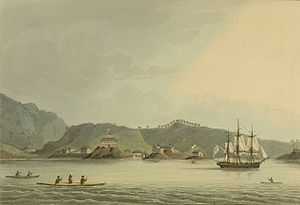Neva (1802 Russian ship)
 The Russian sloop-of-war Neva visits Kodiak | |
| Career (Russian Empire) | |
|---|---|
| Name: | Neva |
| Launched: | 1801 |
| Acquired: | 1802 |
| Renamed: |
Launched as the Thames Renamed Neva in 1802 |
| General characteristics | |
| Tons burthen: | 370 bm |
| Length: | 200 ft (61 m) |
| Sail plan: | Full rigged ship |
| Complement: | 43 |
| Armament: | 14 guns |
Neva was the British merchant vessel Thames, launched in 1802, that the Russians bought that year and renamed Neva. She participated in two trips to the Far East, the first of which was the first Russian circumnavigation of the world.
Thames
Thames was a 200 foot-long (61 meter), three-masted sailing ship of 370 tons burthen built in Britain in 1801.
Russian career
In 1802 Lieutenant Commander Yuri Feodorovich Lisyansky travelled to Britain where he bought two vessels, Thames and Leander.
Thames and Leander left England for the Baltic in May 1803, docking at Kronstadt on 5 June.[1] Czar Alexander I renamed Thames to Neva, after the river, and Leander to Nadezhda ("Hope"). The two vessels sailed in 1803 on a voyage that would become the first Russian circumnavigation of the world. For the voyage Neva carried 14 cannon and a crew of 43 men under Lisyansky's command. The commander of the expedition was Admiral Ivan Fyodorovich Kruzenstern, in Nadezhda.[2]
Neva played a key role in the 1804 battle of Sitka when the Russians recaptured Fort St Archangel Mikhail and the town from the Tlingit, who had captured it in 1802. In 1804, Alexandr Baranov, general manager of the Russian American Company, had failed in his attempt to recapture Fort St Archangel Mikhail with a force of 120 Russians in four small vessels and 800 Aleuts in 300 baidarkas (leather canoes). Baranov returned to Sitka Sound in late September 1804 aboard Neva. Neva was accompanied by the Ermak and two other smaller, armed sailing ships, manned by 150 promyshlenniks (fur traders), along with 400–500 Aleuts in 250 baidarkas. This force succeeded in returning the region to Russian control.[2]
In 1805 Neva discovered Lisianski Island and the surrounding Neva Shoals by running aground there. Lisyansky reported that the island was of little interest, except insofar as its surrounding reefs and shoals posed a threat to passing vessels. Lisyanski was the first to describe the Hawaiian monk seal, which he observed on the island that now bears his name.[3]
In 1805-6, Neva carried a cargo of 150,000 fur seal pelts to China. There she sold them for tea, chinaware and nankeen, which she carried back to Russia.
In 1806-7, Neva made a second trip to the Pacific Ocean, this time under the command of Captain lieutenant Ludwig von Hagemeister. Hagemeister would later become Chief Manager of the Russian American Company. Under his command, in June 1807, Neva became the first Russian ship to the Australian mainland, visiting the newly founded British colony at Port Jackson, modern Sydney,[4] on 4 June 1806.[5]
Fate
Neva was wrecked at Sitka in 1813.
Commemorative coins
In 1993 Russia issued three coins to commemorate the first Russian voyage around the world. One was a 150-roubles platinum coin showing both Nadezhda and Neva on the reverse. The other two were both 25-roubles palladium coins, one for Nadezhda and one for Neva.
See also
Footnotes
References
- Barratt, Glynn (1987). The Russian Discovery of Hawai'I: The Ethnographic and Historic Record. Editions Limited. ISBN 978-0-915013-08-1.
- Massov, Aleksandr (2006). "The visit of the Russian sloop Neva to Sydney in 1807: 200 years of Russian–Australian contacts." Australian Slavonic and East European Studies, Vol. 20, 1-2. School of Languages and Comparative Cultural Studies, The University of Queensland. ISSN 0818-8149.
- Postnikov, A. (2002). Thesis. S.I. Vavilov Institute of the History of Science and Technology of the Russian Academy of Sciences, Moscow, Russia —"The first Russian round the world voyage and its influence on exploration and development of Russian America" accessed September 25, 2005.
- Tredrea, John and Eduard Sozaev (2010). Russian Warships in the Age of Sail, 1696-1860: Design, Construction, Careers and Fates. Seaforth Publishing. ISBN 978-1-84832-058-1.